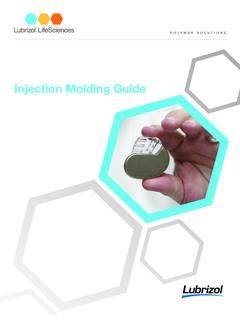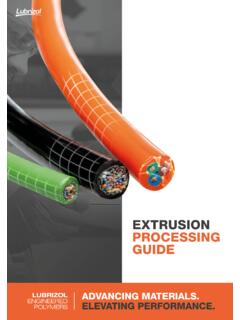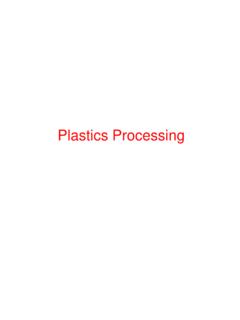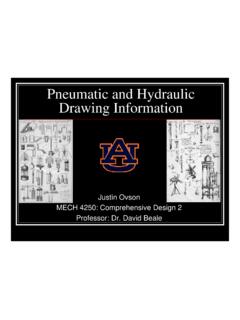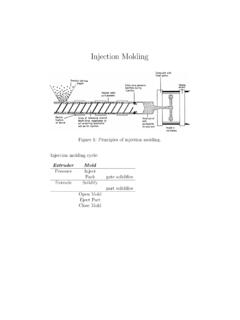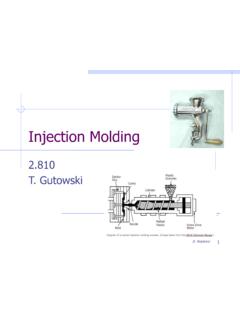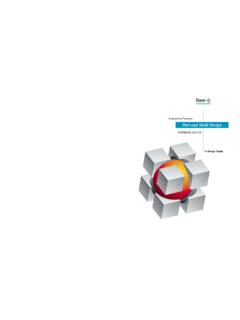Transcription of INJECTION MOLDING PROCESSING GUIDE - Lubrizol
1 INJECTION MOLDINGPROCESSING GUIDEADVANCING MOLDINGPROCESSING GUIDE CONTENTSI ntroduction ..3 Equipment Requirements ..3 Mold and Part Design ..4-6 The MOLDING Operation ..7-9 Start-Up Procedure ..10 Trouble Shooting GUIDE ..112 INTRODUCTIONL ubrizol s portfolio of INJECTION MOLDING grades includes Estane TPU (thermoplastic polyurethane), Pearlthane TPU, Isoplast ETP (engineered thermoplastic), and Estaloc RETPU (reinforced thermoplastic polyurethane). Lubrizol offers soft grades, in the shore hardness range of 70A to 90A, that have a low modulus of elasticity and excellent retention of flexibility at very low temperatures. Additionally, Lubrizol offers harder TPU grades, in the shore hardness range of 50D to 70D, that have a high modulus of elasticity, and excellent low temperature impact strength.
2 All materials produce a very low-viscosity melt that easily fills the most complex mold cavities under low INJECTION pressure. The low viscosity melt permits the material to flow through small gates and into thin wall sections under low INJECTION pressure. Low-viscosity melt combined with low INJECTION pressure minimizes the possibility of producing highly stressed parts. This is significant because many new thermoplastic polyurethane molded parts are painted, and paint systems require baking for 30 minutes at 122 C (250 F). Under these conditions, any molded-in stresses would relieve and the result would be a distorted part. To eliminate this distortion, a time period of 48 hours is recommended before subjecting the molded part to a bake REQUIREMENTSType of MachineAlthough all types of machines have been successfully used, a reciprocating-screw machine is preferred for MOLDING Lubrizol TPUs.
3 A reciprocating-screw machine is capable of producing the most uniform melt, is the most easily controlled, and is capable of the fastest Size Barrel capacity: To obtain the widest PROCESSING latitude and optimum physical properties, an appropriate match of shot size, ( , volume of cavities, runners and sprue) to barrel capacity is very desirable. A shot weight of at least 50% of barrel capacity is recommended. This minimizes melt residence time in the barrel enabling PROCESSING at higher stock temperatures with optimum melt flow while avoiding degradation. Since the optimum match of barrel capacity is not always practical due to clamp requirements or machine availability, shot sizes as low as 30 to 35% may be used with the understanding that the PROCESSING latitude of the material may be significantly reduced.
4 Lower stock temperatures mean higher melt viscosity and more resistance to flow. 3To learn more, visit INJECTION pressures will be needed to fill the part and molded-in stresses may result. It is likely that these molded-in stresses could adversely affect impact, dimensional stability and other properties of the finished part. When calculating optimum barrel capacity, always consider the specific gravity of the TPU versus the specific gravity of the material for which the machine was rated. Most machines are normally rated for kilograms (ounces), a unit of weight of general-purpose polystyrene. Example: Given that the specific gravities of Lubrizol TPUs and general purpose polystyrene are and respectively, a kg (60 oz.)
5 Avoirdupois) barrel rated in general purpose polystyrene will deliver kg (67 oz.)* of TPU. * kg x = kg (67 oz.) targeted shot weight, including sprue, runners and parts, would then be kg (50 oz.) on this machine. ( kg x 75% capacity = kg or 50 oz.)Clamp capacity: A new machine having a minimum clamp force of 300 to 400 kg/cm2 (2 to 3 tons/square inch) of projected part area, including runners, is recommended. The area of runners in a three-plate mold should be included. Screw and Tip The type of screw and tip design that most manufactures call general purpose is best. The compression ratio of most of the general-purpose screws falls between 2:1 and 3:1 and this range is the most desirable for plasticizing Lubrizol TPUs.
6 The general-purpose tip usually has a 60 included angle and an anti-backflow mechanism of either the ball check or sliding ring type. It is recommended that an anti-backflow valve, in good working order, be used when Lubrizol TPUs are molded. The extremely low viscosity of their melts makes satisfactory packing-out of the mold cavity very difficult unless an anti-backflow device is used. Nozzles A straight, open nozzle with a full internal taper tip is recommended. A positive shut off, anti-drool nozzle can be helpful, but is not a necessity. If the particular machine or mold design requires a long nozzle or a nozzle extension, it should be well insulated with heater bands so that there are no cold spots.
7 The harder Lubrizol TPUs, because of their sharp melting point, can be set up if a cold spot exists. The result will be in the next shot, cold slugs of material will be carried into the cavity along with the hot melt. The longer the cycle required by the particular part, the more troublesome this can become; therefore, the nozzle must be well insulated with heater bands. The bands must extend as close to the tip as possible. Molds Any type of mold that incorporates good thermoplastic design principles is satisfactory for Lubrizol TPUs. Two-plate, three-plate and hot-runner molds have all been successfully used for a variety of large and small parts. For hot-runner molds, as with nozzles, it is important that heaters provide full coverage of the runner system so that cold spots do not exist and the TPU can be maintained in its fluid melt state.
8 The mold must also be adequately cored for cooling because Lubrizol TPUs normally require a relatively cool mold (10 C to 80 C) (50 F to 140 F) to produce optimum cycle. The nozzle tips within the hot runner mold must be well insulated from the cold side of the mold. Poor insulation and the quick set-up characteristics of Lubrizol TPUs can lead to plugged nozzles. A sheet of transite separating the hot and cold sections of the mold is AND PART DESIGNS prue BushingA sprue bushing with a standard 21/2 included angle, approximately 42 mm taper per meter ( in. taper per foot) should be used. The entrance diameter of the bushing should always be slightly larger than the nozzle exit orifice. To promote a balanced pressure to the runners and cavities, the exit diameter of sprue bushing should be larger than the diameter of the main runner.
9 Runners In a two-plate mold, full-round runners are preferred because they provide the highest volume-to-surface ratio, the least pressure drop, and are the easiest to eject from the mold. Depending on the part size and weight, typical full-round runner diameters are to cm ( to in.). Because of excessive flow restriction, small diameter runners, less than cm ( in.) diameter, should be avoided. Excessively large diameter runners offer little advantage and contribute to longer cycle times and greater material usage. If a three-plate mold is being used, full-round runners are still preferred, but trapezoidal runners can be 1 shows typical relative dimensions of a trapezoidal crosssection runner.
10 The flow through a trapezoidal runner is equivalent to that of the largest circular runner whose cross-section can be inscribed with the W2. 2/3 W3. 3/4 W4. LFigure 1: Relative Dimensions of a Trapezoidal Runner for Use in a Three-plate MoldW2/3 W3/4 WLTo maintain pressure and balanced flow during INJECTION into a multiple cavity or multigated mold, the secondary runners should be slightly smaller in cross section than the main runner. Secondary runners should be perpendicular to the main runner, and the runner junction should be vapor-honed to remove burrs and sharp edges, and contain a cold slug well at every turn of direction. Figure 2 shows a properly sized runner 2: Proper Running Sizing1.
